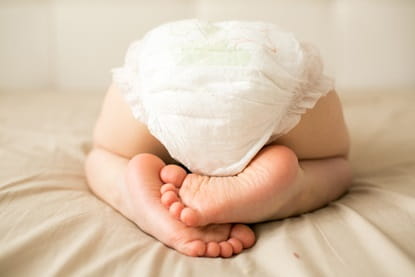Clean as a Baby's Bottom: Bathing and Diapering

It’s time to bathe your baby. Before you begin, know that it might be a little stressful (for you and baby) until you both get used to it – and then you may even enjoy the bonding time. Baths shouldn’t be a daily routine for your newborn. It’s fine to give your baby a bath three times per week, as long as you keep her face, neck and diaper areas clean, according to the Mayo Clinic, which notes too much bath time could cause dry skin.
In addition, the American Academy of Pediatrics says until your baby’s umbilical cord stump shrivels up and falls off, you should give her a sponge bath. The stump should be kept dry and clean. Call your baby’s doctor if it hasn’t fallen off after three weeks.
The Mayo Clinic recommends that you have the following items for a sponge bath:
- A flat surface in a warm place, such as a kitchen or bathroom counter or a changing table; use a towel or blanket to pad a hard surface
- A changing pad, towel or soft blanket for your baby to lie on
- Basic supplies, including a towel (with built-in hood) and washcloth, baby wipes, mild baby shampoo, mild moisturizing soap, clean diaper and clean clothes
- A shallow plastic basin or sink to hold the warm water; check the water temperature to confirm that it’s not too hot
- A free hand; one hand should always be on your baby. You also can use the safety strap on a changing table.
Diaper Duty
Parents magazine recommends the following eight steps to keep this a quick, and clean process:
- While on their back, remove baby’s clothing to gain access to the diaper. Make sure baby isn’t left alone on the changing table.
- Remove the soiled diaper. Stay alert, your baby might pee once you remove the diaper, especially boys.
- Lift your baby up gently to remove the diaper from under the baby.
- Use wipes to clean your baby's diaper region. Always wipe from front to back to prevent infections, especially in girls.
- Look for signs of diaper rash. Use diaper ointment if the area seems red or inflamed.
- Give your baby's skin a second to dry before putting on a fresh diaper.
- Place a fresh diaper under the baby. Bring the front part of the diaper up to your baby's stomach and fasten with the tabs.
- Secure or replace any clothing over the new diaper.
If you have a baby boy who was circumcised, you need to be careful when you change his diapers and when bathing him. The Mayo Clinic notes it typically takes seven to 10 days for the penis to heal after circumcision. It’s fine to wash the penis while it heals, but avoid putting any pressure on it. Change the bandage on the penis every time you change your newborn’s diaper and place a little petroleum jelly on the penis tip to prevent it from sticking to his diaper, which should be loosely fastened.
There might be a plastic ring instead of a bandage, and it will fall off by itself typically within a week, according to the Mayo Clinic. After your baby’s penis has healed, gently wash it with soap and water during bath time.
Number 1 and Number 2
The American Academy of Pediatrics offers guidance about the business end of your baby. She might pee as little as four to six times per day, or as much as every one to three hours, and the color of a healthy baby’s urine will be light to dark yellow. It should never be painful when she urinates, and you should contact your baby’s doctor if she experiences any problems.
Your baby will have her first bowel movements on her birthday and for the first few days afterward. These are called meconium, a thick dark-green or black substance that filled her intestines prior to birth, according to the pediatrician’s organization.
After she passes the meconium, her stools will become yellow-green. If you breastfeed your baby, her stools will be similar to light mustard with particles that look like seeds, and they’ll be very soft, to loose and runny until she begins eating solid foods. If you feed formula to your baby, her stools typically will be yellow or tan and slightly more firm than the stool of a breastfed baby.
Consult your baby’s doctor if you have any questions about bathing, urine, stools or healing from circumcision.




